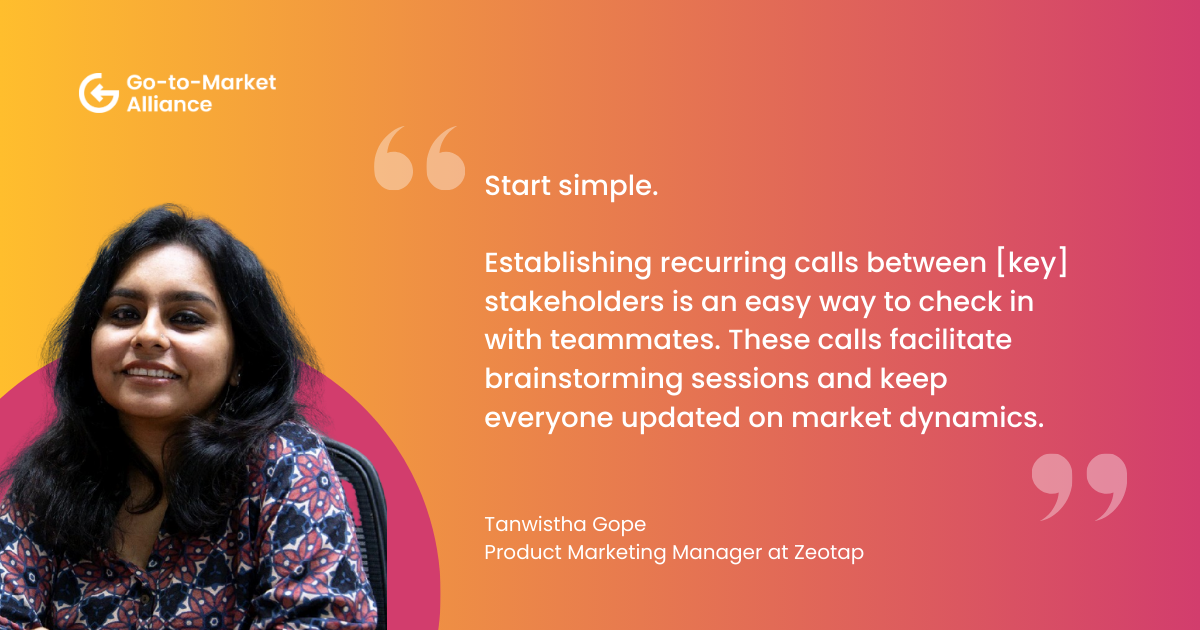A “good” product is set apart by your customers' belief that it is actually helping them solve their problems.
If your customers are unsure what to do with your product, it’s time to use that feedback to improve your current offering.
And there’s a really effective way to translate customer feedback into actionable insights: the collaborative efforts of your Go-to-Market, product, and community teams.
When these teams are aligned and clear on the goals that need to be delivered, they’ll be able to innovate and enhance the customer experience.
In this article, I’ll share some strategies for bridging communication gaps and fostering a collaborative environment among these critical teams, as well as how doing so can get your customers to vouch for your product.
If that sounds good, why don’t we jump right in?
Why team alignment is important
Smooth collaboration between GTM and product teams, especially when working on the target audience or market, starts with aligning both teams around shared goals and objectives.

Identifying key stakeholders from each side who possess subject matter expertise and are involved in decision-making processes is essential.
Team alignment may often feel tricky - with so many stakeholders tracking different key metrics or prioritizing other aspects of a product launch.

But start simple. Establishing recurring calls between these stakeholders is an easy way to check in with teammates. These calls facilitate brainstorming sessions and keep everyone updated on market dynamics.
For instance, at my current organization, the product team conducts weekly calls with Customer Success Managers (CSMs) to address customer feedback. These sessions involve check-ins, reviews, discussions on challenges, and realignment of priorities if necessary.

Similarly, stakeholders from the GTM and product teams can conduct regular calls, either weekly or bi-monthly, to share insights on the target market or audience.
Additionally, conducting regular enablement calls with the sales team can help keep them informed about product launches and beta releases is crucial. These calls should focus not only on the benefits but also on the features that address specific use cases.
In short, these calls should help arm your teams with the knowledge necessary to work better together and deliver on what your unique customers need.
How to facilitate communication with your teams and community
First and foremost, if you want your teams to communicate effectively, you need to establish a clear and streamlined channel specifically for communication. More importantly, these channels should be in place to help bridge the gap between your teams and your customers.
So, where do you start?
Accessible, easy-to-use tools are the way forward. Think Slack channels or a community forum.
You want both team and customers to understand the channel they’re using to reach you.

Similarly, a designated community group or forum means everyone in the GTM and product teams is aware of its importance and can return to it if there are any concerns or questions.
Now, a lot of these responsibilities might fall on the community manager. And it’s this individual’s responsibility to:
- Carry out regular cross-functional meetings: These sync-ups between the GTM, product, and community management teams should focus on discussing feedback trends, prioritizing issues, and aligning action plans.
- Aggregate, categorize and analyze feedback with the GTM and product teams. This helps identify recurring themes, prioritize issues, and provide actionable insights.
- Integrate selected community feedback into the product roadmap based on priority. This not only highlights the importance of community input but also ensures that the product team is aligned with customer needs.
- Promote collaboration between the GTM and product teams through joint initiatives, such as customer feedback-driven campaigns, feature launches, or beta testing programs. This fosters a shared understanding of customer needs and priorities.
- Conduct training and awareness sessions on the importance of community feedback, effective feedback collection methods, and best practices for incorporating feedback into decision-making processes.
- Leverage technology solutions like customer feedback management platforms, analytics tools, and collaboration software to streamline the feedback collection, analysis, and dissemination process.
How to overcome common challenges in aligning community initiatives with GTM objectives
Aligning community initiatives with GTM objectives often presents several challenges.
But that’s not to say you can’t overcome them!
Let’s look at some examples and possible solutions:
- Sometimes, the community and GTM teams have different goals. To address this, clarify how both teams' efforts contribute to the bigger picture.
- Insufficient communication can be a major hurdle. Regular meetings, shared documentation, and collaboration tools can improve communication and ensure everyone is on the same page.
- Limited time, budget, or resources can hinder alignment efforts. Prioritize actions that will best help achieve GTM goals.
- The community team may focus on engagement and relationship-building, while GTM teams prioritize sales. Despite the difference in priorities, aim to find a balance so you can make sure your customers are satisfied.
- Accurately measuring the impact of community initiatives on GTM objectives can be challenging. Develop KPIs aligned with both community engagement and GTM goals and use analytics tools for valuable insights.
- As the community grows, keeping up becomes harder. To manage growth effectively, invest in automation, scalable processes, and community management tools.
A case study in successful collaboration
Let’s quickly look at a real-world example from my organization.
We organize a weekly call named the Product Update Forum, attended by Product Managers, Solution Engineers (SEs), and Implementation Engineers (IEs). During these calls, the Product Manager responsible for the feature gives a demo, covering points of interest to SEs and IEs.
As a Product Marketing Manager (PMM), I highlight the benefits of each feature and discuss achievable use cases. Relevant supporting documents are shared with CSMs to facilitate better adoption. The leadership team mandates that SEs, IEs, and CSMs attend these calls.
Following this, I lead a Sales Enablement call focusing on the business objectives and use cases achievable with the feature launch. We also discuss pricing aspects during these calls.
One notable instance of this collaborative approach was with a recent client, a global gaming company, which encountered challenges with its previous vendor. A successful collaboration between Business Development Representatives (BDRs), Sales, SEs, IEs, CSMs, and the Product Team led to a swift closure of the deal. Their use cases were comprehensively documented, and the Statement of Work (SOW) was concise and specific. Every aspect of their challenges was properly documented, discussed, implemented, and executed.
This achievement was made possible by the regular sync-up calls that the team ensured.
Conclusion
So, we've covered a bit, but let's remember some of the key takeaways here:
🤝 Team alignment is crucial! Effective collaboration between the GTM, product, and community teams is essential for leveraging customer feedback, driving innovation, and ensuring customer satisfaction.
📣 Facilitate communication through regular meetings. Organizations can bridge the gap between these critical teams and achieve their shared objectives by implementing clear communication channels, regular cross-functional meetings, and leveraging technology.
💡 Gather all the feedback you can from customers and internal teams. This will help you and your teams stay creative, innovate, and incorporate those insights into your product roadmap.
📈 Overcoming common challenges and maintaining alignment will lead to a more cohesive and effective strategy, ultimately benefiting the company and its customers.
Want to connect with other GTM pros?
If anything you find has worked for you and your teams while developing your go-to-market strategy, why not share it with our Slack community? This is a great opportunity to meet, connect, and chat with GTM pros worldwide.
Or, if you're aiming to upskill, our Insider Membership or GTM Blueprint can offer you the skills and learnings necessary to really up your GTM game.
And if you want to contribute to our community, get in touch with anyone from our lovely team! We'd love to hear from you.






